Your Planets
Portraits of the Planets
Aspects between Planets
The planetary ages
The planetary families
Planets in Signs
The Planets in comics



For more than 2500 years astrologers have had only one concept intuitive and empirical of what the objective reality of an Aspect is. They confined themselves to observing empirically certain real effects and imagining unreal ones. Very rare and very embryonic have been the attempts at conceptualization and therefore at theorization, such as that exposed by Ptolemy in the 2nd century and that proposed by Kepler in the 17th. Both resulted in erroneous explanations and failures. It is only in the 20th century that the concept of Aspect began to be truly elaborate, making it possible to distinguish the true from the false in the antique and traditional notions and formulate a rational explanatory theory through an overall conception of astrology. The contemporary design and graphical representation of the Aspects are the product of a long history, and the very idea of Aspect has evolved over the millennia.
We observed that many 17th century astrologers considered the parallels of declination or contra-antiscia like Aspects. It is a mistake that has persisted and we will demonstrate it. And by the way, we will rehabilitate the perpendiculars of declinations or contra-antiscia, unjustly neglected by most ancient or contemporary astrologers.
The video below (6′ 53″) is a commented animation of declensions, antisces & counter-antisces.
The figure below shows, on the sinusoid of the ecliptic surrounded by its zodiacal band, a parallel of declination between Mars in Libra and Jupiter in Pisces. In the following figures, this sinusoid is replaced by a zodiac circle to illustrate the same astronomical phenomenon.
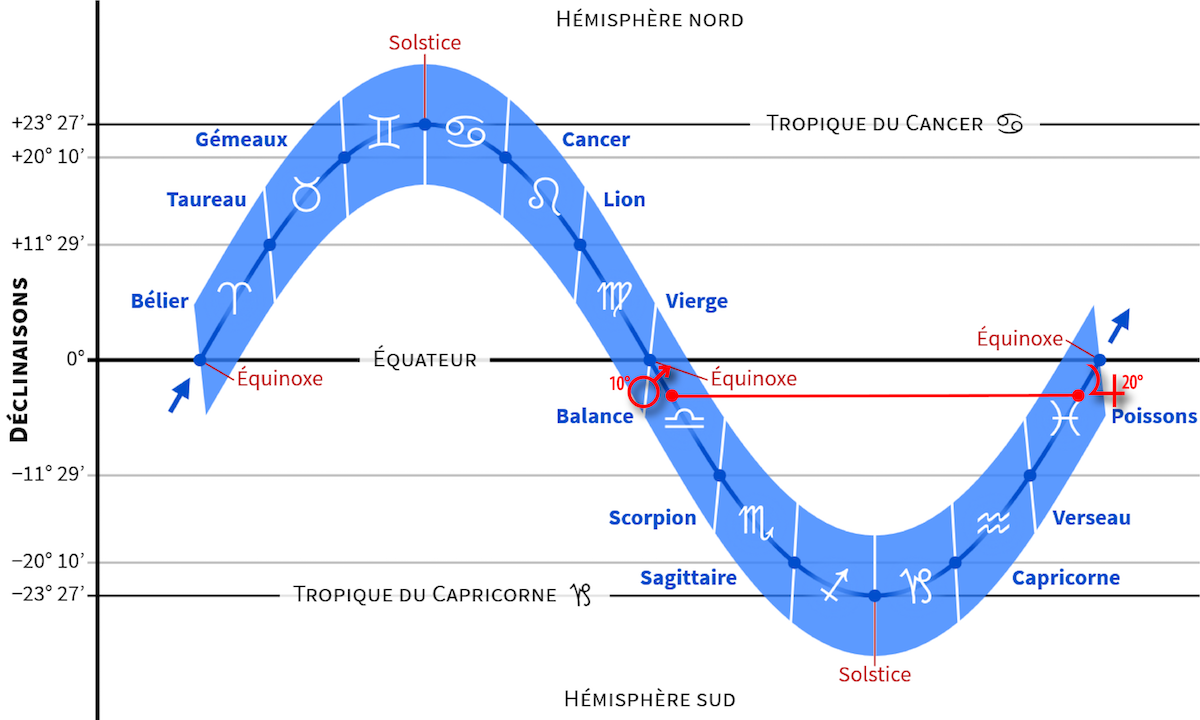
In the figure below, we notice that Mars at 10° Libra and Jupiter at 20° Pisces exactly on the ecliptic are located on degrees of their Signs which are parallel to the equator and are located at −10° to the South of this one. They thus form a parallel of declination, also called antiscia. The antiscis is therefore measured perpendicular to the solstitial axis and parallel to the equatorial plane. In this example, the angular difference between them (160°) is not that of any major or minor Aspect: it is located between the orb of opposition and that of the trine. The Minor Aspect it would come closest to would be a quincunx (150°) of which it is, however, largely out of the admitted orb and who is otherwise disqualified by the Aspect theory. There can also exist as many antisces as there are degrees on a semi-circle divided by 2 (couples of planets in antisce), namely 90° without an orb. We thus better understand the very careful orb recommendations from those considering them and for some call them Aspects. A tiny orb of 1° to 2° which is explained by their uncertainty on this subject… and by the implicit desire to limit as much as possible, by this artifice, the possible number of antisces.
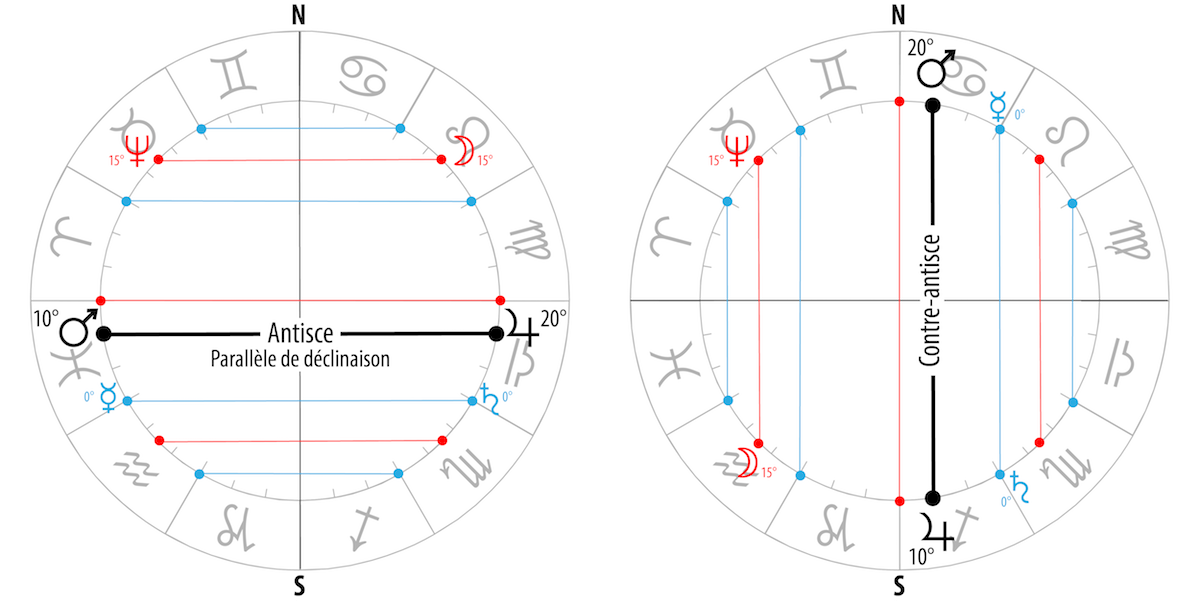
And anyway, the antiscis, or parallel of declension, is not an Aspect. A true Aspect is characterized by a standard angular deviation between two planets. However, this characteristic is lacking in the antiscis, which can be characterized by a very wide variety of angular deviations (from 0° to 180°) depending on the declination of the planets it connects, a figure which corresponds to as many durations intercyclic. Now this spectrum from 0° to 180° is the one that contains all the possible Aspects, from conjunction to opposition. The position of an antisce can be identical to that of an Aspect, superimposed on it or be contained within its orb. In these precise cases, the tiny orb of the antiscis is located inside the capital orb of the Aspect… Finally, we must not forget that the antiscia is the partner in declension of the counter-antiscis, which is measured perpendicular to the equinoctial axis and the equatorial plane.
The pie chart from the left above represents a antiscia And two Aspects. The red and blue line segments represent respectively the dissonant (squares, opposition) and consonant (sextiles, trines) Aspects. The black horizontal line segment represents the antiscis. Its position does not matter: it is only an example.
In this graph, the antisce connects Mars at 10° Pisces and Jupiter at 20° Libra: they are declinations parallel to that of the equinoctial axis going from 0° Aries to 0° Libra located just above. We notice the existence of two exact Aspects: the square (90°) of Neptune in Taurus to the Moon in Leo at 15° of their respective Signs, as well as the trine (120°) of Mercury in Aquarius to Saturn in Libra at 0° of their respective Signs. These Aspects are exact, as we have seen previously, whatever their ecliptic latitude. The exact Mars-Jupiter antisce requires, on the contrary, that their longitudes be opposite and that their latitudes be identical, and the orb of 1 or 2° generally accepted for the antisce tolerates very little margin of latitude and longitude. Finally, note that the Neptune-Moon and Mercury-Saturn Aspects correspond to antisces. An antisce can therefore be superimposed on an Aspect and merge with it. What will distinguish them then will be precisely the ecliptic latitude, coordinate irrelevant in the case of the Aspect and not only relevant, but above all decisive in the case of antiscience.
The antiscis is therefore determined by both its latitude and its longitude, just as the actual planetary positions are in Signs. This means that it falls under the repository of Signs: he is not an Aspect, but a particular moment of a zodiacal phase and must therefore be understood and interpreted as such. From this point of view, two mirrored Signs on either side of the sostitial plane, such as Taurus/Leo on the one hand, and Aquarius/Scorpio on the other, can be linked by 30 antisces if we accept the uniform (and arbitrary) extent of 30° per Sign. And among these 30 antisces, only one of them can superimpose an exact Aspect between two planets in these Signs. It is necessary for that that these planets in Aspect are located at 15° of the latter. In the other cases, Aspect and antisce cannot be confused, except inside the orb admitted for the antisce, and should not be, since they belong to distinct registers of coordinates, even if their common point lies in the longitudes. From this point of view, the antisces are phenomena which show the coordination between the two fundamental characteristics of the periodicity of a planetary cycle: its aspectal and zodiacal components.
The correlation between the antisces and the zodiacal phases that are the Signs becomes evident if we consider the latter from the point of view of their photoperiods. Indeed, the declinations zodiaco-planetary have a direct effect on the variations of day and night times. The latter only translate into days and nights in the particular case of the Sun: the zodiac is therefore not of solar essence.
The concept of photoperiod (Greek photos = light) that we will now use was not chosen to designate this cycle of variation because light would be the physical signal that would explain the nature of the astrological influence. The presence of light makes an object visible, and its absence makes it invisible. There photoperiod of a planet therefore designates the ratio between its diurnal duration of visibility above the horizon, which can be described as “presence”, and its nocturnal duration of invisibility below the horizon, which can be described as “absence”.
These photoperiods are the joint effects of terrestrial declinations and latitudes. Under a latitude equatorial, the durations of diurnal presence and nocturnal absence of a planet in Sign are always substantially equal. In areas tropical, their inequalities are more important and, in latitudes beyond the polar circles, they are at their maximum inequality, the presence-absence relationship being reversed from one hemisphere to the other. Between the tropical and polar zones, therefore in the so-called median zones “temperate”, these variations in the presence-absence ratios are significant without being extreme. These photoperiodic day-night or day-night relationships mean, by the way, that there is a universal zodiac, common to the two terrestrial hemispheres, which is that of the declinations; and local photoperiodic zodiacs whose effects vary depending on the terrestrial latitudes and reverse from one hemisphere to the other.
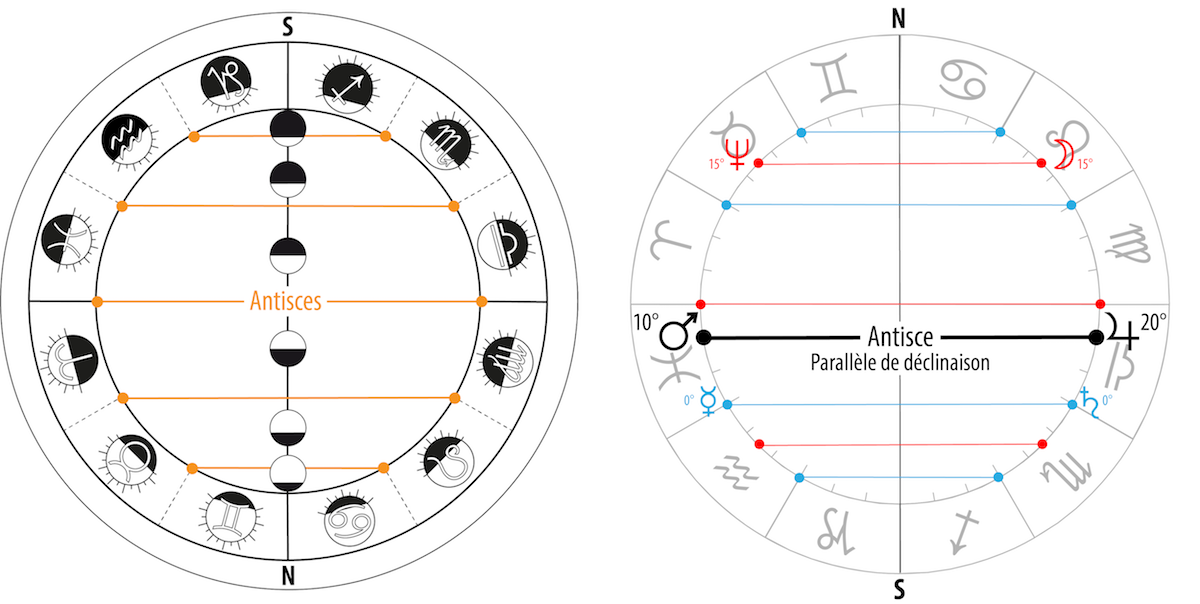
The graphic to the left above represents the photoperiodic variations of the zodiac cycle for a terrestrial latitude of 45° North. The horizontal orange line segments represent the antiscial areas determined by the limits of each Sign. Each sign symbol is surrounded by a circle divided horizontally into two parts, the white representing the diurnal and the black the nocturnal. The rays indicate which of these is croissant in duration. We observe that the Signs having the same antisces have the same ratio of diurnal-nocturnal duration: sensible equality for the equinoctial Pisces-Aries-Virgo-Libra, maximum inequality for solstitials Gemini-Cancer-Sagittarius-Capricorn, and mean inequality for Signs medians Taurus-Leo-Scorpio-Aquarius. The 6 central and vertical circles show these similarities between these Signs in antisces. What differentiates each Sign from an antiscial duo is the increasing or decreasing character of the dominant duration.
The pairs of antiscial signs are therefore: Aries-Virgo, Taurus-Leo, Gemini-Cancer, Libra-Pisces, Scorpio-Aquarius and Sagittarius-Capricorn. The Signs belonging to these pairs have in common the same diurnal-nocturnal ratio and nocturnal durations greater than diurnal in the South and less in the North, but are distinguished by the growth (expansion factor) or the decrease (retraction factor) of the diurnal or nocturnal element which dominates in duration. For the interpretations of these duos-duels, see the articles devoted to them.
Finally, note that these antiscial relationships between Signs exist regardless of whether or not there are exact or admitted orb parallels of declination between two planets. They affect the totality of each Sign. Thus, for example, if a Chart is characterized by a strong planetary occupation of Aries and Virgo, these antiscial characteristics will be one of the important elements that can be used in its interpretation, whether or not these planets are linked by antisces in their orbs.
If the contra-antiscia enjoy a certain popularity among some astrologers, the contra-antiscia are unjustly neglected, whereas the relations between the Signs which they designate are of major importance. The pie chart below represents two aspects and one counter-antiscis (vertical black right segment). As for the antiscis, its position does not matter: this is again only an example.

In the graph of right, the counter-antisce connects Mars at 20° Cancer and Jupiter at 10° Sagittarius: they are declinations parallel to that of the solstitial axis ranging from 0° Cancer to 0° Capricorn and perpendicular to that of the equinoxes. We note the existence of two exact Aspects: the square (90°) of Neptune in Taurus to the Moon in Aquarius at 15° of their respective Signs, as well as the trine (120°) of Mercury in Cancer to Saturn in Scorpio at 0° of their respective Signs. These Aspects are exact, as we have seen previously, whatever their ecliptic latitude. The Neptune-Moon and Mercury-Saturn Aspects correspond to counter-antisces. A counter-antisce can therefore, like an antisce, be superimposed on an Aspect and merge with it.
The graph below represents the photoperiodic variations of the zodiacal cycle for a terrestrial latitude of 45° North. The vertical orange line segments represent the antiscial zones determined by the limits of each Sign. The 12 central and vertical circles show the similarities between these Signs in counter-antisces. The Signs belonging to these couples are characterized by a same ratio of day-night durations but these durations are inverse: if the diurnal dominates in duration in one, it is the nocturnal which has the longest duration in the other, and vice versa. Finally, like the antisces, they are also distinguished by the growth (expansion factor) or the decrease (retraction factor) of the diurnal or nocturnal element which dominates in duration.
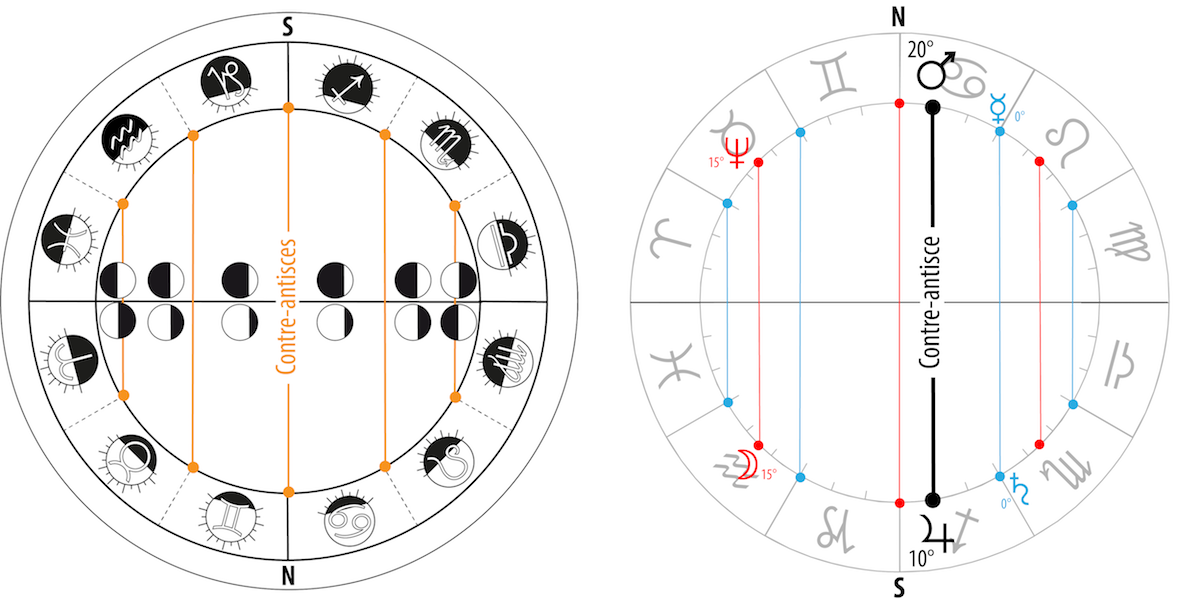
The pairs of counter-antiscial signs are therefore: Aries-Pisces, Taurus-Aquarius, Gemini-Capricorn, Cancer-Sagittarius, Leo-Scorpio and Virgo-Libra. The Signs belonging to these couples are inverse symmetries which make them complementary-opposites: what is strong in one is weak in the other, and vice versa.
Take the example of couple Gemini-Capricorn. Both are determined by the extreme inequality of diurnal-nocturnal durations. At the Gemini, the diurnal increasing in duration is at its maximum, the decreasing nocturnal at its minimum. The dominant diurnal being a factor of Excitation strength and growth a factor of expansion, this Sign is thus characterized by a force of excitation (openness, positive responses) tending to generalize in a context of optimal expansion (the next Sign, Cancer, will mark the end of this expansion with the diurnal decrease). At the Capricorn on the contrary, the nocturnal decreasing in duration is at its maximum, the increasing diurnal at its minimum. The dominant nocturnal being a factor of inhibition and decrease a factor of retraction, this Sign is thus characterized by a force of inhibition (closure, negative responses) tending to generalize in a context of optimal retraction. These two Signs therefore have in common only their tendency to generalize And for the rest, everything opposes them. In short, they are almost totally antithetical. And it is the same for the other zodiacal couples located in mirror perpendicular to the equinoctial axis and to the plane of the equator.
The signs counter-antiscials are thus linked by a relationship which is the equivalent of an opposition on the plane of the Aspects, in the sense that in one case as in the other, it is a question of different tendencies that clash. And if, to keep the same example, a Chart is characterized by a strong planetary occupation of the counter-antiscial couple Gemini-Capricorn and there is an opposition between two or more of these planets, its dissonant effects underlining the contradictions will be increased by compared to those of the same Aspect, for example in Gemini-Sagittarius. Indeed, in this case, this opposition is between two Signs in dynamics of maximum expansion: it is therefore less antagonistic than an opposition in a zodiacal context of antithesis between maximum expansion (Gemini) and maximum retraction (Capricorn).
The effects of pairs of counter-antiscial Signs are also very decisive in the case of synastries (Comparisons of Charts). From this point of view, it is useless to specify that the relations and interactions between two individuals having, one a strong dominant Gemini and the other a strong dominant Capricorn, can only be difficult and complex, even extremely conflictual if they do not fail to make their zodiacal antagonisms into complementarities.
The contra-antiscia and contra-antiscia are therefore not Aspects. It is abusive and misleading, from an astronomical point of view, to qualify them as such. Like the ecliptic latitudes, they constitute a zodiac parameter having its effects, which can be superimposed on those of the Aspects but cannot be confused with them.
▶ Aspects theory and practice
▶ Les aspects, phases d’un cycle
▶ Aspects : existe-t-il un modèle traditionnel ?
▶ Aspects : théorie et bilan conditionaliste
▶ Introduction à l’interprétation des aspects
▶ The planetary Aspects and their orbs
▶ Les Aspects kepleriens
▶ Les “aspects” aux Angles
▶ Chronologie des Aspects et Transits
▶ Les Aspects planétaires
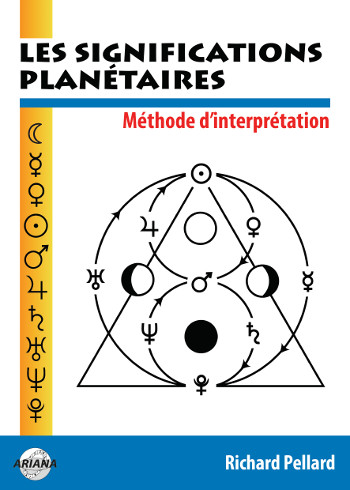
Les significations planétaires
par
620 pages. Illustrations en couleur.
La décision de ne traiter dans ce livre que des significations planétaires ne repose pas sur une sous-estimation du rôle des Signes du zodiaque et des Maisons. Le traditionnel trio Planètes-Zodiaque-Maisons est en effet l’expression d’une structure qui classe ces trois plans selon leur ordre de préséance et dans ce triptyque hiérarchisé, les Planètes occupent le premier rang.
La première partie de ce livre rassemble donc, sous une forme abondamment illustrée de schémas pédagogiques et tableaux explicatifs, une édition originale revue, augmentée et actualisée des textes consacrés aux significations planétaires telles qu’elles ont été définies par l’astrologie conditionaliste et une présentation détaillée des méthodes de hiérarchisation planétaire et d’interprétation accompagnées de nombreux exemples concrets illustrés par des Thèmes de célébrités.
La deuxième partie est consacrée, d’une part à une présentation critique des fondements traditionnels des significations planétaires, d’autre part à une présentation des rapports entre signaux et symboles, astrologie et psychologie. Enfin, la troisième partie présente brièvement les racines astrométriques des significations planétaires… et propose une voie de sortie de l’astrologie pour accéder à une plus vaste dimension noologique et spirituelle qui la prolonge et la contient.
Téléchargez-le dès maintenant dans notre boutique
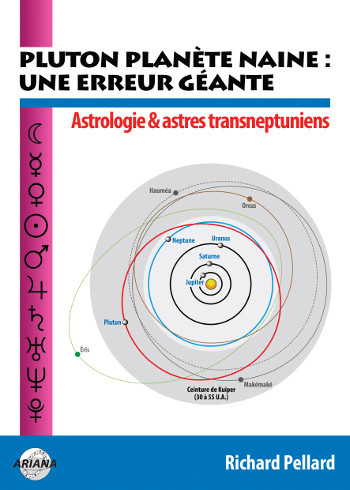
Pluton planète naine : une erreur géante
par
117 pages. Illustrations en couleur.
Pluton ne fait plus partie des planètes majeures de notre système solaire : telle est la décision prise par une infime minorité d’astronomes lors de l’Assemblée Générale de l’Union Astronomique Internationale qui s’est tenue à Prague en août 2006. Elle est reléguée au rang de “planète naine”, au même titre que les nombreux astres découverts au-delà de son orbite.
Ce livre récapitule et analyse en détail le pourquoi et le comment de cette incroyable et irrationnelle décision contestée par de très nombreux astronomes de premier plan. Quelles sont les effets de cette “nanification” de Pluton sur son statut astrologique ? Faut-il remettre en question son influence et ses significations astro-psychologiques qui semblaient avérées depuis sa découverte en 1930 ? Les “plutoniens” ont-ils cessé d’exister depuis cette décision charlatanesque ? Ce livre pose également le problème des astres transplutoniens nouvellement découverts. Quel statut astrologique et quelles influences et significations précises leur accorder ?
Enfin, cet ouvrage propose une vision unitaire du système solaire qui démontre, chiffes et arguments rationnels à l’appui, que Pluton en est toujours un élément essentiel, ce qui est loin d’être le cas pour les autres astres au-delà de son orbite. Après avoir lu ce livre, vous saurez quoi répondre à ceux qui pensent avoir trouvé, avec l’exclusion de Pluton du cortège planétaire traditionnel, un nouvel argument contre l’astrologie !
Téléchargez-le dès maintenant dans notre boutique